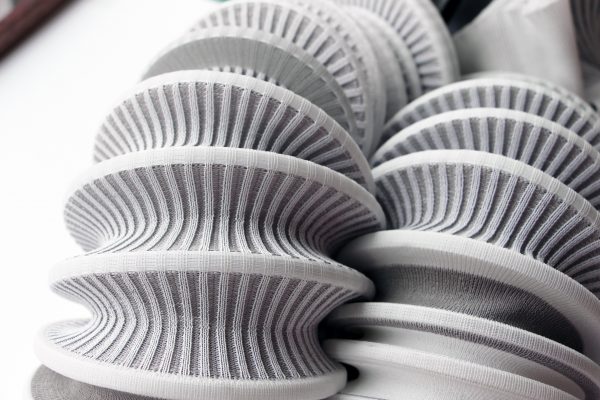8月29日〜9月2日に開催いたします、アン・トゥーミー氏のワークショップ「インテリジェント・テキスタイル — 医療・福祉・スポーツの未来像」にあわせて、パブリックレクチャーを開催いたします。ぜひご参加ください。

Sculptural Knitted Piece – Nikki Jones 2014. Image courtesy of RCA.
講師 アン・トゥーミー(英国王立芸術学院 テキスタイル部門プログラム長)
日時 2016年8月31日(水)19:00- 20:30
会場 京都工芸繊維大学60周年記念館
概要
「医療・福祉分野向け多感覚応用素材システム」
テキスタイルとテキスタイル型の素材は人工的な環境の大部分を成し、体内の血管・皮膚組織から宇宙、深海、極地という極限環境に至るまで我々の生活のほとんどすべてに組み込まれている。テキスタイル技術は現代社会、さらには必ずや未来の環境にも遍在する。
デザインがポスト‐デジタル時代、新素材の時代に移行し、身体を取り巻くすべてに感応する可塑的、直観的で人間中心のエコシステムである未来の素材世界は、我々のニーズに呼応すべく人間生活の質を向上させ、自然環境を分断なく共存させる体験とサービスを提供するだろう。指標でも明らかに、素材技術の躍進により、輝かしい商業化時代に突入していることが理解される。非在来の特質を持つ形状記憶、センサー、エネルギー交換、色返還、光通信学や自己集合が生物学的反応性、発光、環境発電、自己修復や健康と福祉の監視・管理を行う製品やシステムの創出を可能にする。
先端性を有す新たな製品領域は、高齢化、コミュニティの繋がり、原料の枯渇、廃棄物管理やエネルギー供給という21世紀の課題において、一層、資源としての必要性が高まっている。我々は自分たちの暮らしをより楽に、より良く、そしてよりシンプルにしてくれるものを作る必要がある。。
明日の製品は、より少ないものでより多くのことができなければならない。
これは、特に医療と福祉分野において確かなことである。
デジタル技術の進歩は、健康で自立した生活から、より依存しケアを必要とする生活へと変わっていく人生の過程において、我々の生活をより簡単に、より良く、よりシンプルにするために、スマートで複合的な製品システムと共に生きる機会を与えてくれた。
データやコミュニケーションといった、形のない世界が急速に進化する一方、それらと相互作用する物質という有形の世界はまだ成熟していない。ウェアラブル・テクノロジーにつながる素材の幅を広げる可能性とはいかなるものだろうか。また、このことがもたらす機会とはどういったものだろうか?
新規の素材によって可能となったウェアラブル・テクノロジー向けの新素材とはどのような姿だろうか。形あるものとりわけテキスタイルが、活発なユーザーとしての高齢者向けの技術関与において中心的な役割を担うことができるだろうか?この多感覚への応用が、どのように将来の医療および福祉分野におけるシナリオにおいて、そのあり方を証明するのだろうか。
Anne Toomey’s public lecture will be on August 31 from 19.00 – 20.30 at the 60th Anniversary Hall.

Sculptural Knitted Piece – Nikki Jones 2014. Image courtesy of RCA.
Lecturer: Anne Toomey, Head of Programme, Textiles, Royal College of Art
Date: August 31, 19.00 – 20.30
Venue: 60th Anniversary Hall
Summary:
‘Multi-sensory material systems for healthcare and well being’.
Textiles and textile-type materials make up a significant proportion of our man-made environments and are incorporated into almost every aspect of our lives from stents and tissue scaffolds within our bodies to the extreme environments of space, deep sea and polar regions. Textile technology is omnipresent in our current world and, inevitably, our future environment.
Materials with unconventional properties such as shape memory behaviour, sensing, energy exchange, colour change, photonics and self-assembly enable us to create products and systems that are bio responsive, emit light, harvest energy, self repair, monitor and manage our health and well being.
Advances in digital technologies have opened opportunities for living with smart, complex product systems to make lives easier, better and simpler during the life journey from health and independence to increasing dependency and care. This will become more evident as notions of the quantified self and digital technologies become more pervasive in our lives and we become more dependent upon them. As we shift from taking care of our products to our products taking care of themselves and eventually taking care of us suggests future scenarios of wearable technologies as soft satellite devices in a seamless, connected personal ecosystem within the Internet of Things.
Whilst the intangible worlds of data and communication have evolved rapidly, the tangible world of the materials that interface with them is yet to mature.
What are the possibilities of broadening the range of the materials that interface with wearable technologies and what opportunities does this then present?
What are the new material expressions for wearable technologies enabled by emerging materials? Can we think radically about how materiality – and textiles in particular – can play a key role in the engagement of technology for older citizens as active users and how this multi-sensory engagement might manifest itself in future healthcare and well being scenarios?